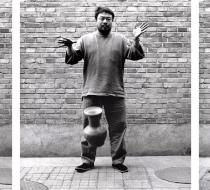Heritage loss and the Importance of the Past Favorite
Dropping a Han Dynasty Urn (1995) by Ai Weiwei is a highly provocative work of art. This series of three black and white photographs portray the artist holding a 2,000-year-old Han dynasty urn that, frame by frame, he drops, it falls, and shatters. As much a work of photography as a work of performance art, in each still an unaffected Ai looks directly at the camera aware of his destructiveness. In fact, to capture the action on film (rather than digital photography, which lets you review the image immediately), the artist actually broke two ceramic vessels, just in case. This kind of blatant destruction of artifacts may seem highly irreverent, yet it also forces viewers to consider issues of transformation and destruction of the past.
Ai Weiwei has chosen an unusual way of continuing this legacy of transforming the material past while at the same time expressing dissent against a country that sometimes obliterates its own cultural heritage: through direct confrontation. On the one hand we can view his work as a destruction of another artist’s work; on the other, Ai’s act can also be thought of as a kind of collaboration with an ancient artist over thousands of years—a revitalization. Once an ancient receptacle, the urn in Dropping a Han Dynasty Urn takes on new meaning as contemporary art. In Ai’s work, the object is less a vessel than an emblem of Chinese history. For this performance, it seems that the object selection is almost immaterial—it might as well have been any ancient object. However, in recognition of Ai’s own celebrity, the artist has transformed this urn into something of great significance just by selecting it to become the subject of his art, by including its name in the title, and, of course, by destroying it. The sensationalism of breaking something so old and rare is what modern audiences find so compelling. Here the nostalgia for what once was serves as a mirror, reminding us that China’s past remains important and relevant today.
Some were outraged by this work, calling it an act of desecration. Ai countered by saying, “Chairman Mao used to tell us that we can only build a new world if we destroy the old one.” This statement refers to the widespread destruction of antiquities during China’s Cultural Revolution (1966–76) and the instruction that in order to build a new society one must destroy the si jiu (Four Olds): old customs, habits, culture, and ideas. By dropping the urn, Ai lets go of the social and cultural structures that impart value.
The event that Ai Weiwei created and captured in these photographs is one of violence. Many feel that it is unethical to destroy an artifact under any circumstances—that such an act indicates a lack of value and respect. Indeed, law professor Joseph Sax calls such destruction a kind of “unqualified ownership” because it enables “the indulgence of private vice to obliterate public benefits.” [3] Certainly, the destruction of art for ideological or egoistic reasons reflects badly on a collector of ancient objects. Yet was Dropping a Han Dynasty Urn a true obliteration? The Han dynasty urn still exists for the public but it has been transformed into the form of captured film stills. The loss of one object gives the new artwork its potency.
Ai himself says that he considers the act of dropping the urn one of creation rather than destruction: “People always ask me: how could you drop it? I say it’s a kind of love. At least there is a kind of attention to that piece [because of the photograph].” [4] From the artist’s point of view, his act was one of preservation through transformation. Indeed, this triptych (set of three photographs) and the shadow of the vessel captured within it now receive unprecedented attention. These photographs are displayed in museums and public institutions around the world. The work is widely available online, and even the focus of academic essays like this one. Given Ai’s own celebrity status and the significance of this artwork, Dropping a Han Dynasty Urn is also now far more valuable than the original ceramic object. In 2016, this limited edition work sold for nearly 1 million dollars at Sotheby’s Auctions in London. [5]
(From Smarthistory)







